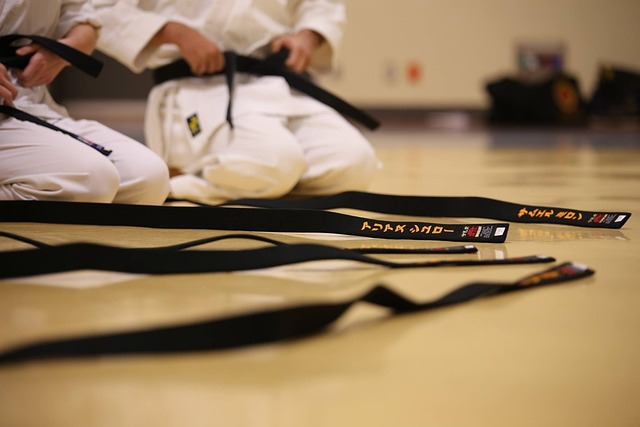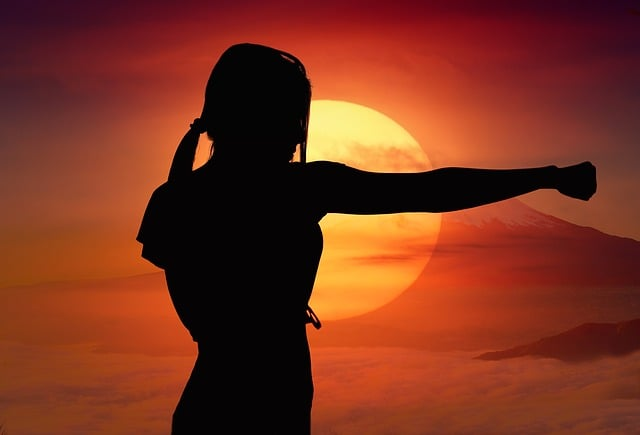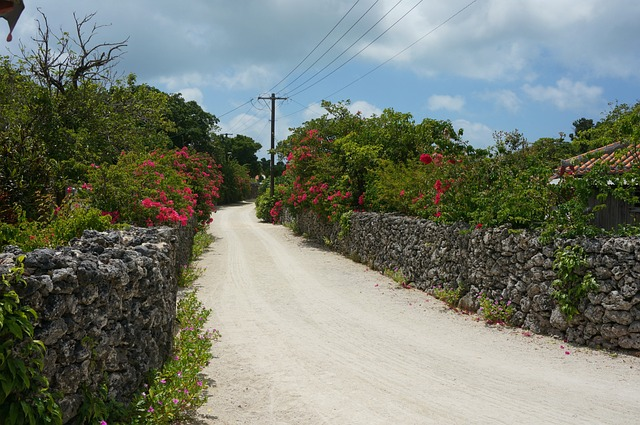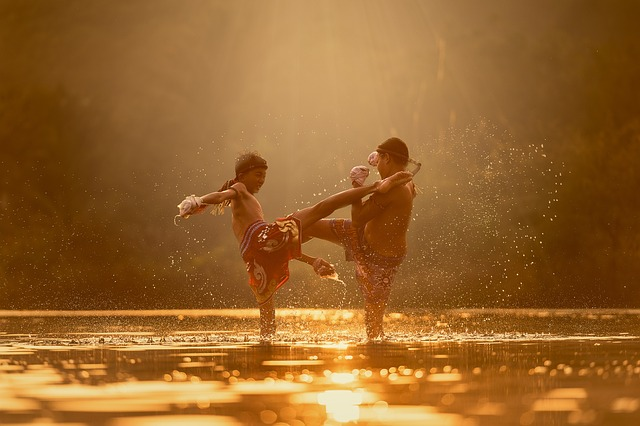
Martial arts isn’t just a physical endeavor. Students often want to know about the cultural and historical aspects of the martial art they practice. As students progress in their martial arts training, they usually deepen their practice by learning about martial arts history, such as the origins of karate. What makes a simple history lesson so important for successful training?
It’s a well-known fact that one of the biggest obstacles to learning martial arts is plain old consistency. Struggling with consistency isn’t uncommon; people often drop out of any practice that challenges them. It’s easy to be excited and engaged for the first few months of anything but much harder to continue past that initial excitement.
Cultivating a deeper understanding of the history of the martial art you’re practicing is more valuable than you might realize. Your knowledge of the culture surrounding the martial art you practice strengthens your training; it can help you continue striving to practice even when you feel tired or demotivated.
We’ve got the crash history course on the origins of karate and how it ties to the history of Chinese martial arts to deepen your practice with a better understanding of this popular martial art.
The Ancient Roots of the Martial Art of Karate
Unearthing the Origins in Okinawa, Japan
Travel back in time to the enchanting landscapes of Okinawa, Japan, where the seeds of Karate were first sown. As the Ryukyu Kingdom flourished, so did the need for self-defense.
Local warriors, brimming with ingenuity, devised a powerful system of various unarmed combat techniques, that relied solely on their bare hands and feet. Little did they know that this art, known as Karate, would transcend time and borders, leaving an indelible mark on martial arts history.
Like many martial arts, the most ancient origins of karate are found in mainland China. Much of Japanese culture traces back to mainland China, though it has evolved and differentiated itself and is a distinct culture today.

To understand this, look at the Japanese writing system; you’ll note that one of their three writing systems—kanji—is based on Chinese characters.
Karate traces its origins to an island in the far south of Japan—Okinawa. Okinawa is part of the Ryukyu Islands which were ruled by China until the 1800s. The people of Okinawa have a distinct regional culture that’s different from mainland Japanese culture.
The scholar-officials of the island of Okinawa traveled back and forth to mainland China in the centuries before Okinawa became Japanese. During this time, the fighting system that would eventually be known as karate most likely evolved from the White Crane fighting style—a southern Chinese martial arts form.
Mastering the Art of “Empty Hand”
How Karate Became a Formidable Self-Defense Technique
The term “empty hand” might sound deceivingly simple, but make no mistake, Karate is a captivating martial art that embodies grace, power, and precision.
As the Okinawan martial arts warriors honed their techniques, they transformed their bodies into lethal weapons.
Through rigorous training and discipline, an Okinawan karate master learned to harness their inner strength, transforming ordinary actions into extraordinary displays of skill. Thus, Karate emerged as a formidable self-defense technique, making use of the most potent tool any warrior possesses – their own body.
A Fusion of Cultures
The Harmonious Blend of Okinawan Karate and Chinese Martial Arts
Karate’s uniqueness lies in its diverse heritage. Influenced by a rich tapestry of cultures, it is the beautiful fusion of indigenous Okinawan karate fighting styles and Chinese martial arts.
As Okinawa served as a bustling trade hub, it welcomed travelers from distant lands, who brought with them a treasure trove of knowledge including those of Asian martial arts.
The locals keenly absorbed and adapted these teachings, blending them harmoniously into the art of Karate. This symbiotic relationship between cultures gave birth to a truly distinctive and powerful martial art.

From Local Secret to Global Phenomenon
Karate’s Journey Around the World
Once a closely guarded secret within its shores, Okinawan Karate broke free from its island confines and embarked on a journey that would span continents.
As Japan embraced this Okinawan karate, it soon found itself crossing oceans and touching the hearts of people worldwide. From dojos in Japan to studios in Europe, America, and beyond, the popularity of Okinawan Karate soared, captivating countless practitioners and earning its place as a global phenomenon.
Beyond the physical movements and techniques, Karate embodies a deeper philosophy – one that transcends the realm of combat and permeates into every aspect of life. Its practitioners learn to respect others and themselves, fostering humility and empathy. The pursuit of excellence and continuous self-improvement becomes a way of life, empowering individuals to face challenges with unwavering courage.
Through the centuries, Karate has served as a vessel for passing down the wisdom of generations, from master to disciple, preserving traditions and values that withstand the test of time. It encourages practitioners to explore the depths of their inner selves, seeking harmony and balance between mind, body, and spirit.
As the legacy of Karate continues to expand globally, it stands as a unifying force, bringing people together across cultures and languages. The shared passion for this ancient art transcends boundaries and creates an international community bonded by mutual respect and camaraderie.
For centuries, the art of Karate remained a well-guarded secret, passed down through generations within Okinawa’s tight-knit communities. However, in the early 20th century, a pioneering figure emerged – Master Gichin Funakoshi. He introduced Karate to mainland Japan and later to the world, breaking the chains of its secrecy.
With each passing decade, Karate spread its wings beyond Japan’s borders. Enthusiastic practitioners, armed with dedication and passion, carried the art to foreign lands, exposing it to diverse cultures. The discipline and benefits of Karate resonated deeply with people worldwide, attracting a growing community of practitioners hungry for its profound teachings.
Modern Karate Origins in Japan
Many Okinawans traveled north to the main islands of Japan in the early twentieth century in search of work. They brought the Okinawan style of martial arts to the main Japanese islands.
Students of traditional Japanese martial arts may know that the Japanese word means “empty hand.” During the early history of karate, the name was written as “Tang hand” or “Chinese hand.”
What brought about this name change?
In the 1920s and 1930s, the Japanese were becoming more militarized and nationalistic, as well as correspondingly more at odds with China.
Karate began to be taught to students and members of the military. As such, they began teaching them to write it as “empty hand” instead of “Chinese hand.”

Modern Origins of Karate in America
Aikido, Judo, Jujutsu, and even Sumo wrestling are all traditional Japanese martial arts you’ve probably heard of. You may have trained in these martial arts styles and art forms or you have seen them in popular media like movies and comic books, making an understanding of martial arts history even more interesting to learn.
Karate is the best-known Japanese martial art and the most popular outside of Japan. The reason for karate’s international popularity requires understanding the origins of modern karate itself, which eventually reaches the point where America occupied Japan after the Second World War.
Readers and martial arts trivia buffs: take one guess where a main American military base ended up being located in Japan? Okinawa.
Americans learned Japanese Karate and participated in the ancient martial art both on the mainland and on Okinawa. When they returned to America, some former military and government servicemen decided to open up Karate schools and dojos. Karate became one of the first mainstream martial arts practiced in America.
It’s also why you know the famous martial arts movie as “The Karate Kid” and not the “Aikido Boy” or the “Judo Teen.”
In more recent times, different Japanese martial arts practices have gained in popularity, but Karate is one of the oldest martial arts in the Western world and continues to grow in popularity.

Honoring the Legacy
Embrace the Spirit of Karate and Its Rich History
The spirit of Karate lies not just in its powerful movements but also in the profound history it carries. Today, as practitioners step into the Karate dojo, they embrace a legacy that stretches back centuries.
The dedication and discipline of the ancient Okinawan warriors continue to resonate in every punch, kick, and block.
By taking part in Karate training, we pay homage to those brave souls who crafted this art with passion and purpose, ensuring that their legacy lives on in the hearts of modern practitioners.
The Karate’s origins form a tapestry of history, culture, and philosophy. From its humble beginnings in Okinawa to its global prominence today, this art has endured the test of time.
As practitioners carry the torch of tradition forward, they honor the legacy of the brave warriors who dared to forge an art that transcends borders and speaks to the very essence of the human spirit.
Karate remains not just an art of self-defense but a profound journey of self-discovery – a path that continues to inspire and empower countless individuals around the world.
Wrapping It Up
In this ever-changing world, where the pursuit of progress often leads to disconnection from the past, Karate remains a beacon of heritage and identity. Through its practice, individuals not only pay homage to the courageous warriors of ancient times but also find a sense of belonging to a timeless legacy.
As we honor the origins of Karate, let us also celebrate its evolution into a modern-day art form that continues to inspire and enrich lives. From the dojo to the world stage, Karate has become a symbol of resilience, perseverance, and the unwavering pursuit of excellence.
In the footsteps of those who came before, modern karate practitioners carry the torch of tradition with pride and gratitude. They embrace the spirit of Karate, fostering a global community united by a shared passion for self-improvement, discipline, and the pursuit of harmony.
So, as we contemplate the remarkable journey of Karate, let us acknowledge its deep-rooted heritage, embrace its teachings, and pass on its wisdom to future generations. For in doing so, we not only preserve a treasured martial art but also nourish the human spirit, fostering a world where respect, humility, and courage thrive. The origins of Karate continue to inspire and empower, lighting the way for a future enriched by the timeless principles it embodies.
Start Practicing Karate Today
Are you ready to include this ancient and international martial art practice in your life? Karate is a powerful practice to increase your physical and mental health—just find a local Premier Martial Arts studio near you and start reaping the benefits. Now that you know the origins of karate, it’s time to experience the power of Karate training.








